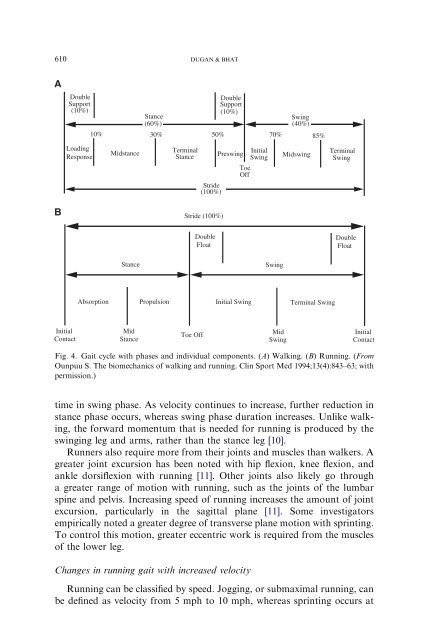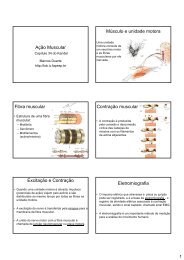Biomechanics and Analysis of Running Gait - De Motu
Biomechanics and Analysis of Running Gait - De Motu
Biomechanics and Analysis of Running Gait - De Motu
Create successful ePaper yourself
Turn your PDF publications into a flip-book with our unique Google optimized e-Paper software.
610 DUGAN & BHAT<br />
A<br />
B<br />
Double<br />
Support<br />
(10%)<br />
Stance<br />
(60%)<br />
Double<br />
Support<br />
(10%)<br />
Loading<br />
Response<br />
Initial<br />
Contact<br />
10% 30% 50% 70% 85%<br />
Absorption<br />
Midstance<br />
Stance<br />
Mid<br />
Stance<br />
Propulsion<br />
Terminal<br />
Stance<br />
Stride (100%)<br />
Toe Off<br />
Stride<br />
(100%)<br />
Double<br />
Float<br />
Preswing<br />
Initial Swing<br />
time in swing phase. As velocity continues to increase, further reduction in<br />
stance phase occurs, whereas swing phase duration increases. Unlike walking,<br />
the forward momentum that is needed for running is produced by the<br />
swinging leg <strong>and</strong> arms, rather than the stance leg [10].<br />
Runners also require more from their joints <strong>and</strong> muscles than walkers. A<br />
greater joint excursion has been noted with hip flexion, knee flexion, <strong>and</strong><br />
ankle dorsiflexion with running [11]. Other joints also likely go through<br />
a greater range <strong>of</strong> motion with running, such as the joints <strong>of</strong> the lumbar<br />
spine <strong>and</strong> pelvis. Increasing speed <strong>of</strong> running increases the amount <strong>of</strong> joint<br />
excursion, particularly in the sagittal plane [11]. Some investigators<br />
empirically noted a greater degree <strong>of</strong> transverse plane motion with sprinting.<br />
To control this motion, greater eccentric work is required from the muscles<br />
<strong>of</strong> the lower leg.<br />
Changes in running gait with increased velocity<br />
Initial<br />
Swing<br />
Swing<br />
Swing<br />
(40%)<br />
Terminal Swing<br />
Terminal<br />
Swing<br />
Double<br />
Float<br />
<strong>Running</strong> can be classified by speed. Jogging, or submaximal running, can<br />
be defined as velocity from 5 mph to 10 mph, whereas sprinting occurs at<br />
Toe<br />
Off<br />
Mid<br />
Swing<br />
Midswing<br />
Initial<br />
Contact<br />
Fig. 4. <strong>Gait</strong> cycle with phases <strong>and</strong> individual components. (A) Walking. (B) <strong>Running</strong>. (From<br />
Ounpuu S. The biomechanics <strong>of</strong> walking <strong>and</strong> running. Clin Sport Med 1994;13(4):843–63; with<br />
permission.)



